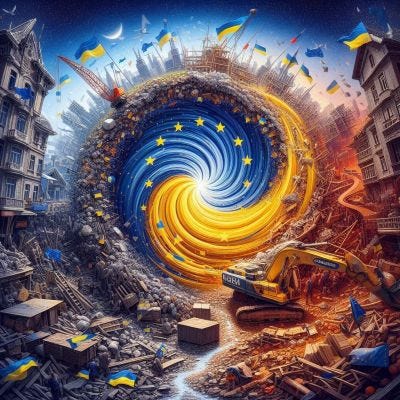Clearly angered by the intensification of Russia’s air campaign against Ukraine, Donald Trump has pivoted from the suspension of US military assistance to Ukraine to promising its resumption. Russia’s strikes on major cities killed more civilians in June than have died in any single previous month, according to UN figures. Over the past two weeks, the US president has made several disparaging comments about his relationship with Vladimir Putin, including on July 13 that the Russian president “talks nice and then he bombs everybody in the evening”.
Not only will the US resume the delivery of long-promised Patriot air defence missiles, but Trump is now also reported to be considering a whole new plan to arm Ukraine, including with offensive capabilities. Additionally, he has talked about imposing new sanctions on Putin’s regime and putting 100% tariffs on any countries buying Russian oil unless there is a deal within the next 50 days.
This is the general background against which the eighth Ukraine Recovery Conference took place in Rome on July 10 and 11. The event, attended by many western leaders and senior business executives, serves as an important reminder that the war against Ukraine will be decided on the battlefield, but that peace will only be won as the result of rebuilding Ukraine’s economy and society.
Ending the war anytime soon and on terms favourable to Kyiv will require an enormous effort by Ukrainians and their European allies. The country’s recovery afterwards will be no less challenging.
According to the World Bank’s latest assessment, as of the end of 2024, Ukraine’s recovery needs over the next decade stood at $524 billion.
With every month that the war continues, these needs are increasing as the damage grows that Russia’s aggression causes, including to housing, transport, and energy infrastructure – the three hardest-hit sectors which account for around 60% of all damage, according to the World Bank.
At the same time, the International Monetary Fund (IMF) provided a relatively positive assessment of Ukraine’s overall economic situation at the end of June, with economic growth forecast at between two and three percent for 2025 and likely to grow to over 4 percent in 2026 and 2027. However, the IMF also cautioned that this trajectory, and the country’s macroeconomic stability more generally, will remain heavily dependent on external support. This is especially the case as the IMF also projected a potential gap in Ukraine’s budget for next year of up to $19 billion.
The cumulative pledge of over €10 billion at the Ukraine recovery conference, therefore, is both encouraging and sobering at the same time. It is encouraging in the sense that Ukraine’s international partners remain committed to the country’s social and economic needs, not merely its ability to resist Russia on the battlefield. Of particular note in this context is the EU’s announcement of a new €2.3 billion support package, consisting of €1.8 billion of loan guarantees and €580 million of grants. This constitutes more than one-quarter of the EU's €9.3 billion commitment in the Ukraine Investment Framework.
And yet, it is also sobering that even these eye-watering sums of public money are still only a fraction of Ukraine’s needs.
Even if the EU manages to mobilise its overall target of €40 billion for Ukraine’s recovery, by attracting additional contributions from other donors and the private sector, this will constitute less than 8 percent of Ukraine’s recovery needs as of the end of last year.
As the war continues and more of the diminishing public funding is directed towards defence expenditure by Kyiv’s western partners, this gap is likely to grow over time.
And money is not the only problem for Ukraine recovery efforts. Rebuilding the country is not simply about undoing the damage done to infrastructure and economic performance. The social impact of Russia’s aggression is similarly hard to over-estimate. Ukraine has been deeply traumatised as a society since the beginning of Russia’s full-scale invasion in February 2022.
Generally reliable casualty counts — some 12,000 civilians and 43,000 troops killed since February 2022 — still likely underestimate the number of people who died as a direct consequence of the Russian aggression, each of whom will have left behind family members struggling to cope with their loss. In addition, there are hundreds of thousands of war veterans.
Already during the period between Russia’s illegal annexation of Crimea in 2014 and the launch of the full-scale invasion eight years later, there were nearly half a million veterans. By the end of 2024, this number had more than doubled to around 1 million. Most of them have complex social, economic, medical, and psychological needs that will have to be considered as part of a society-wide recovery effort.
According to data from the UN refugee agency (UNHCR), there are also some 7 million refugees and 3.7 million internally displaced people (IDPs), roughly equivalent to one quarter of Ukraine’s population. UNHCR’s financial needs in Ukraine are estimated at $800 million in 2025, of which only 27% were funded as of the end of April.
Once the fighting in Ukraine ends, refugees are likely to return in greater numbers. This is likely to provide a boost to economic growth in Ukraine as they will strengthen the country’s labour force and bring with them skills and potentially investment.
But like many IDPs and veterans, they may not be able to return to their places of origin — either because these are not inhabitable or because they will remain under Russian occupation.
Some returnees will likely also be viewed with suspicion or resentment by those who stayed behind and fought. Tensions with Ukrainians who survived the Russian occupation in areas that Kyiv may recover in a peace deal are also likely, given Ukraine’s harsh anti-collaboration laws.
As a consequence, reintegration, in the sense of rebuilding and sustaining the country’s social cohesion, will be a massive challenge requiring as much, if not more, of Ukraine’s partners’ attention and financial support as the country’s physical reconstruction and the transition from a war to a peace-time economy.
Given the mismatch between what is needed and what is provided for Ukraine’s recovery, one may well be sceptical about the value of the annual Ukraine recovery conferences. But it is to the credit of their organisers and attendees that they recognise that the foundations for post-war recovery need to be built before the war ends. The non-military challenges of war and peace must not fall by the wayside amid an exclusive focus on battlefield dynamics.
An earlier version of this analysis was published by The Conversation on July 14, 2025.
We hope you'll share Navigating the Vortex with anyone you think might find it of interest. Also, you can listen to our podcast editions via the website and on all major podcast platforms, including:












